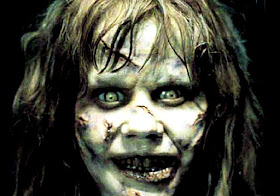Information and articles on anything and everything! The most exciting site on the planet!
The Movie - The Exorcist
Director William Friedkin's classic horror film "The Exorcist" had its New York City premiere on June 19, 1973, staking its claim in the pop culture consciousness (with a sledgehammer) and changing the face of horror cinema forever. The story of a young girl, Regan (Linda Blair), possessed by a vulgar yet devilishly clever demon who makes for quite the wake-up call for a young priest (Jason Miller) wrestling with a crisis of faith became notorious for reports of audience members fainting from fright ... and for becoming an instantly quotable cult favorite thanks to Regan's rather colorful turns of phrase whilst under the influence of pure foul-mouthed evil.
So who dreamed up this crazy yarn, anyway? Incredibly enough, "The Exorcist" isn't just the product of someone's wild imagination; it's actually based on a real-life event, though how much of that event is "true" is entirely a matter of personal ... well, faith.
"The Exorcist" was based on the 1971 novel of the same name by William Peter Blatty, which was in turn inspired by the exorcism case of Roland Doe, a pseudonym given to the victim by the Catholic Church. Most of the details surrounding Doe's alleged possession and exorcisms come from a diary kept by the attending priest, Fr. Raymond Bishop, and from newspaper reports that came from an at the time anonymous source, which was later revealed to be the Doe family's former pastor, the Reverend Luther Miles Schulze. Later, Thomas B. Allen wrote a book about the case, "Possessed: The True Story of an Exorcism" (published in 1993), which was based on two sources: Bishop's diary and the testimony of Fr. Walter Halloran, one of the last surviving eyewitnesses of the events and a participant in the second leg of exorcisms.
Roland Doe was born circa 1936 into a German Lutheran Christian family, who lived in Cottage City, Maryland, during the 1940s. Roland was an only child and was particularly close with his Aunt Harriet, a spiritualist who introduced him to a Ouija board. When Harriet died in St. Louis when Roland was 13, it is assumed that the boy tried to contact her via the Ouija board.
Roland's alleged possession came about in mid-1949, shortly after Harriet's death. Strange noises started to occur in the Doe house, including squeaky and marching feet. Furniture moved by itself and objects levitated. A container of holy water placed near the boy smashed to the ground. According to a report made by Reverend Schulze to Washington D.C.'s The Evening Star, Roland was examined by both medical and psychiatric doctors, who could offer no explanation for these events.
Reverend Schulze arranged for Roland to spend the night at his home for observation. During the night, Schulze heard vibrating sounds coming from Roland's bed and scratching on the wall. An armchair in the room allegedly tipped over and blankets moved around the room of their own accord. Schulze concluded that evil was at hand and arranged for Roland to receive the Lutheran rite of exorcism.
The case was then referred to Rev. Edward Hughes, a Roman Catholic priest, who performed the exorcism on Roland at Georgetown University Hospital. Roland inflicted a wound on Hughes that required stitches, which stopped the exorcism and sent the boy home. Roland developed strange welts on his body while his family was en route to St. Louis, where his cousin contacted one of his college professors, Rev. Raymond J. Bishop, who in turn brought in his colleague, the Rev. William S. Bowdern. Both priests visited Roland at his relatives' home and witnessed furniture moving of its own accord, the boy's aversion to anything sacred and him speaking in a guttural voice. Bowdern received permission from the archbishop to perform the exorcism in secret, provided that a detailed diary be kept.
Bowdern was assisted by Fr. Walter Halloran and the Reverend William Van Roo. Halloran reported that words such as "evil" and "Hell" appeared on Roland's body during the exorcism, and at one point Roland also broke Halloran's nose. The ritual of exorcism was performed on the boy over 30 times over the course of several weeks.
When the final exorcism was over, the Doe family was no longer troubled and moved back to their home. Roland went on to become a successful and happily married man, a father and a grandfather.
Nine priests and 39 other witnesses signed the final ecclesiastical papers documenting Roland's experience, with Halloran, Bowdern and Bishop all going on record as to believing Roland's case to be one of actual possession. There have been several investigations of the events over the years, including an article written by Mark Opsasnick that challenges the supernatural aspects of the case. Opasasnick came to the conclusion that "those involved saw what they were trained to see" and that Roland Doe "was simply a spoiled, disturbed bully who threw deliberate tantrums to get attention or to get out of school."
Whether the case of Roland Doe is true (or at least partially true) or not, it makes for a great story, one that inspired a great book that in turn inspired a great movie. "The Exorcist" was nominated for ten Academy Awards and won two (Best Adapted Screenplay and Best Sound Mixing), becoming the first horror film to ever be nominated for the Oscar for Best Picture (it lost to "The Sting"). The film is also one of the most commercially successful films of all time, grossing over $441 million in worldwide box office on a budget just shy of $11 million.
And, 40 years later, it's still giving us nightmares ... and a healthy aversion to pea soup.

